Click here to read all of the posts in the “Where have I been?” series (if you haven’t you should probably start from the beginning, before you read on!) Also, you can click on any of the photos for a bigger version.
Part V: San Carlos de Bariloche, Argentina to Parque Nacional Nahuel Huapi
The first thing is the wind.
I’ve heard about the wind – how it permeates everything. How every facet of life is (directly or indirectly) shaped by it, from the barren landscape to the Goretex coats for sale in expensive boutiques downtown.
It shakes and rattles us – our old aluminum bird groaning with displeasure. The vibrant green life of the coast has given way to the drab khaki and grey of the Patagonian Steppe and for must be thousands of miles, we’ve seen nothing.
But now we’re so close – so close to the ground, so close to landing – and we’re still flying above that same nothing. This is it. We’re about to crash into the desert. The wind will toss us up and down until – like a cat – she’s finally bored and we careen into the sandy, scrubby Earth.
Stepping outside of the airport, the wind greets us again.
“Remember me?!” She screams, trying to steal our Santa hats as Mariana and I pose for one of the many pictures which will make up our unquestionably adorable christmas card for our families.
I shiver – the air a stark contrast to the heavy humidity of the jungle.
We’ve made it to San Carlos de Bariloche, Argentina. Technically in the Lakes District, but really the gateway to Patagonia – the giant expanse of wilderness that encompasses most of the bottom tip of South America.
Bariloche is famous for the breath-taking lakes and snow-capped mountains that surround it, the eclectic culture dictated by the obvious Swiss influence (particularly its many boutique chocolate shops), and – of course – unpredictable weather, often manifested in extreme winds.
The bus drops us in the center of the town – which looks like it’s been air-lifted from Sunday River or Vale – and we nearly freeze to death as we lug our packs seven brutal blocks uphill to our hostel. A spectacular view waits at the top, but we hardly turn around before ducking inside where a warm fire is beckoning. We’re starting to question. It sure was sunny in Quito and Buenos Aires and Iguazu…
A couple of American volunteers staff the reception and tell us that just a few days ago they had been down at the lake – on the beach! – and sunbathing. It had been in the 80s. I’m wearing every piece of clothing I own; I’m skeptical.
We like Bariloche. Despite its frigid welcome, the town warms up to us. We’ve actually decided to change our plans a bit – staying a bit longer and taking a more direct route to our next stop, giving us more time to relax and do some hiking in the area.
Today, we’re prepping for a few days in the wilderness. Parque Nacional (PN) Nahuel Huapi is a great expanse of (relatively tame) mountains to the south and west of the city. Our plan is to spend a few days back-packing on what appear to be well-traveled and well-maintained trails. A bit of a warm-up trip for the more intense wilderness backpacking we have planned for later in the trip.
We spend the day getting ready to go. I (literally) run all over town trying to find a store that will rent us a tent (apparently similar to trying to find a goose that lays golden eggs), stock my back-pack full of ramen and snickers and canned tuna, and finally meet back with Mariana at our hostel where we spread out all our belongings in the open courtyard and begin to pack.
The sun is out – it’s been out all day. But, like clockwork, as soon as our mess of gear is strewn about the grass (we’re even in the process of test-assembling the tent), we start hearing faint “ping, ping, pings.”
Tiny raindrops turn to little white hail-stones which (as we frantically throw all of our belongings into the hostel common room) turn to more severe, crystallized ice M&Ms. Mariana and I look at each other with mild concern.I tell her not to forget her rain gear.
One of the benefits of being so far south (about the latitudinal equivalent of Massachusetts) is that daylight here lasts well into the evening. Because the time-zone skews the days here differently than our northern summer, Bariloche sees daylight until close to 10pm around the summer solstice (just a week or so away). So, despite having spent far longer than we’ve expected packing up our gear (“we’ll catch the 2pm bus – nope, 3pm, wait, no 4pm?”), we decide to catch the 5pm bus out of town and start our adventure with a short evening on the trail.
The bus takes us along the lakefront on a paved highway and then up into the foothills outside of the city – the road deteriorating proportionally with the altitude. Eventually, we end up at the base of Cerro Catedral – a ski-mountain in the winter and base for outdoor activities in the summer.
We’re in a ghost town. A few gaggles of teenagers, part of some type of summer program (and all with matching embroidered jackets) seem to be returning from a long day of… something. Otherwise, we’re alone.
Our plan is to take the gondola (still operated during the summer) up to the top of the Cerro Catedral ridge. From there, what has been described as a beautiful walk will take us across the peak to the first refugio – or mountain lodge – where we can camp. The national park has a handful of these refugios strewn about in a convenient arrangement. For a few (or a lot, depending on your budget) extra dollars, hikers can backpack without having to carry much of anything, as the refugios can provide hot, home-cooked meals in addition to a (questionably) comfortable bunk bed.
We’ve decided to pack our own tent. Not only does it provide a great feeling of moral superiority (we don’t need your soft bed and hot soup! Ha!), but it gives us a sense of flexibility (and safety) by not being tied down to camping in any one spot. I’m happy to carry a little extra wait.
It’s almost 7pm by the time we start up the trail. There has been some confusion – some changing of plans. See, that gondola – the one that the book swore was open and would swoop us up to the top of that ridge in a matter of minutes – that gondola closes. At 5pm! Can you believe it? 5pm in Argentina is essentially noon!
And so here were are. It’s 7pm but feels like early afternoon, the sun still high and bright with no sign of tiring. The afternoon hail seems to have passed and within a few minutes we’re taking off layers and putting on sunblock and hiking in t-shirts.
The day’s walk follows an obvious and well-trodden trail away from the ghost-ski-town and up, up, up around the backside of the Catedral peak. After an hour or so, we hit a valley and follow the trail upwards. In the shadow of the mountain now, the air has cooled, though our effort increases as we climb higher and higher.
Our plan is to head to Refugio Frey. We’ll camp there, but it’s always nice to have the facilities of the cabin if we want to get water, have our dinner inside, meet some folks. About a mile down the trail on our map, we see another campsite listed, though, and upon arrival, we decide that this will be our home.
Not only are we tired from the long day of packing and now hiking (was that really just one day?), but the campsite is spectacular. Named Casa de Piedra (House of Stone), the campsite has a picnic table, a few flat spots for camping, and a rustic log frame built into the nook created by an enormous, overhanging boulder. Moreover, the campsite is empty; the scurrying of animals and the soft white noise of the nearby river our only companions. The solitude is nice.
The next morning, we pack up and leave Casa de Piedra and make the short walk up to Refugio Frey where we stop for breakfast. Much like the shelters in the White Mountains of New Hampshire, the refugio is staffed by knowledgeable, outdoorsy folk who offer us juice and hot tea.
They also inform us that our planned route is impossible. Due to an unusually heavy snow-fall, an important section of trail connecting one side of the national park to the other (skirting over a very high mountain ridge) has been deemed unsafe without serious snow gear (which we don’t have). They show us an alternative route – a slightly shorter loop – and assure us that this should be fine for us, given our experience and gear.
We bid farewell to our new friends at Frey and circle around a lake. The craggy spines of Cerro Catedral loom over us and we know we’re headed up towards them. This will be our first major pass (a saddle between two mountain peaks) and it looks intimidating.
We spend the first hour on a steep face full of loose rock. I can see there’s snow up where we’re headed, but it looks like we might be able to avoid it.
We can’t. Or, we don’t. The snow is soft and we follow the footprints of whoever has come before us and arrive at a plateau with a bright, clear lake. The high point of the pass still hovers above us, so we rest for a few minutes before beginning the next ascent.
We cross a decently steep snowfield, noticing (but not acknowledging) the fact that a slip would result in tumbling down into the undoubtedly frigid alpine waters below us. The last hundred feet or so is over troublingly loose rock – each step sending a cascade of smaller rocks careening downward.
But we make it up.
The top of the pass yields a spectacular panorama of both where we’re headed and where we’ve been. The giant lake is visible far to our right, while in front of us lies the dark green valley we’re about to enter and the second steep wall of mountains we need to cross before arriving at Refugio Jakob, where we’ll camp this evening. Again, the mountains are spotted with snow (dubbed “cow mountains” for the pattern of the patches of white snow and black earth) and I wonder if we’ll be able to work around it. I hazard a guess that, no, we’ll be back on the snow before we know it and we head down.
The descent from the pass is extremely steep and made up almost entirely of loose rock with no discernible trail. I can see the spot where we’ll enter the woods far, far below us, but other than that, I’m just going down.
It’s a slow and tedious descent – Mariana not confident on the rocky footing and steep, intimidating drop; arriving in the woods is a welcome relief. Despite knowing that we have another serious pass to cover, the few miles of flat woods trail that follow the bottom of the valley bring mental and physical respite.
The day started out sunny, but by the time we get to the beginning of the second ascent, clouds – and even some light snow – have rolled in and chilled things down. We can see a group of three climbers ahead of us (the first we’ve noticed), which brings great relief that we’re on the right track.
The second pass is more straight-forward. As expected, the snow is unavoidable. But I had found us some sticks in the woods which served as makeshift ice-axes, and the snow becomes much more manageable.
At the top, we meet the threesome we’d been tracking for a few hours – a couple of 20-something British guys and one Argentine. They, too, are headed to Refugio Jakob (what seems like a stone’s throw below us), and we tell them we’ll meet them there.
We arrive with plenty of light to spare and quickly set up our tent. In contrast to the solitude of the night before, we find a half-dozen other tents and even more folks staying inside. But the refugio is heated by an old cast-iron furnace and the people seem to be generally friendly, so I don’t mind the commotion. It’s been a long day. We barely make it past sunset.
With what had turned out to be an aggressive day under our belts, the next morning, we decide to enjoy a more relaxed, casual morning.
It’s beautiful. Hot enough for shorts and sunny enough to merit sunglasses and bandanas. We leave our packs and make a quick trip over to Laguna de los Tempanos (Iceberg Lake), where we have breakfast and lie out in the hot sun – in contrast to the blocks of ice floating a dozen feet away.
The hike from Jakob out to the main road is a long, gradual descent. No steep climbing or scrambling down rock faces today. What looks to be a tiny town is labeled “Colonia Suiza” (Swiss Colony) and we set this as our destination for the evening. It’s not too far to the main road, but close to double to get all the way to Colonia Suiza. We’re counting on getting picked up by a bus or hitch-hiking (or we’re going to be very tired).
The walk down is calm – if not boring. The day is still sunny and wonderful and only gets hotter as we descend through the valley. The scenery rolls by and we play word games to pass the time.
“Ice pack.”
“Pack animal”
“Animal Planet!”
“Planet Hollywood”
“Hollywood Boulevard”
And so on.
In the mid afternoon, we come to the end of the trail which dumps us onto someone’s farmland. We follow the dirt driveway another mile down to the main road which, to my horror, is not the paved, bustling highway that I had imagined (filled with buses or cars ready to pick us up and zoom us down to Colonia Suiza, saving our tired legs a few hours of walking). No, this is a dirt road with a sign that says closed to vehicular traffic.
As I mentally prepare to walk for another 4 or 5 hours, a car pulls up. I can’t believe it.
“Where are you guys headed?” The driver is a young guy; his girlfriend sits across from him. We answer.
“We’re not going quite that far, but I can take you as far as our house,” he replies.
“Any distance is great!” We reply, and we help him carry the tires and other heavy machinery out of the back seat and hop in.
Coming from the US, hitch-hiking is generally not something that’s acceptable in the 21st century. Outside of a few unique areas (around the Appalachian Trail in Vermont and New Hampshire), I haven’t seen or participated myself in any in my home country. But in South America, particularly in and around national parks, the idea of getting a lift from a stranger is still common and even relied upon. And so, despite my paranoid American upbringing, I smile and watch the miles tick by.
We walk the last few miles to Colonia Suiza and find what appears to be another ghost town. The two campsites we find both require what I deem to be a king’s ransom to simply pitch your tent, so we spend a few infuriating hours asking around, looking for a quiet spot in the woods, before finally deciding to give into the extortion and camp in town.
We pass one more house that shows signs of life and decide to ask – just on the off-chance that they might let us camp there. We’re met by a woman who restores my faith in humanity.
“Pay? No, no… just camping? You can put your tent up in our yard. But do you need to cook? You can use our kitchen if you need. And our showers. And electricity. Whatever you need my dears!”
We wake up the next morning in these strangers’ back-yard and leave our tent to find a group of construction workers staring at us. This back area where we’re camping is being renovated and apparently we’ve slept past their start time. We smile and wave.
Again, we walked way longer than planned for the day before and decide to take another relaxing morning. Colonia Suiza is right on the big lake, so we walk over to the public beach and spend a couple hours enjoying the sunshine.
We’re debating what to do next. We could go back into the woods – up another trail – but with so much snowed over, we can’t make any more loops. And just going out and back doesn’t seem that appealing.
We decide to relax and head back into Bariloche that afternoon. We have the option to keep our tent, so maybe we’ll camp just outside of town at night. Who knows – we can do whatever we want, after all!
We end up back in Bariloche. Having returned to the joy of civilization, we decide not to camp, but return our tent and check into a room at Hostel 1004.
One of the cooler and friendlier hostels I’ve ever seen, 1004 is named for its apartment number – having commandeered the 10th floor penthouse of what appears to be the tallest building in Bariloche. The common spaces are beautiful with giant windows looking out over the bright blue lake and white snow-caps in the distance.
Christmas Eve comes the next day. Mariana and I have a tradition (well, it’s a tradition now after two years) of sharing a long run/bike-ride together on Christmas Eve morning. Last year, it had been a frigid 24 miler on the Boston Marathon course. This year, I run in American flag shorts and a t-shirt for 15 beautiful miles through (another) national park.
We spend the next two days enjoying our lack of structure and plans. We have a wonderful pot-luck Christmas dinner at 1004. We make friends. We run up a mountain overlooking town. We feel no pressure to do anything in particular, but just enjoy being here and being together.
Our next flight leaves the morning of the 26th. I get in one last, early run along the lakefront – now almost used to the forceful hand of the wind pushing me and holding me back – before we lug our packs to the bus station and then to the airport. It’s been a wonderful week – with both enough adventure to satiate our young vivacity and enough relaxation to calm ourselves back down.
But now, we’re boarding another plane and heading off – heading south. We’re going to the End of the World (the Fin del Mundo) – to Tierra del Fuego. And I’ve heard it’s even windier down there.

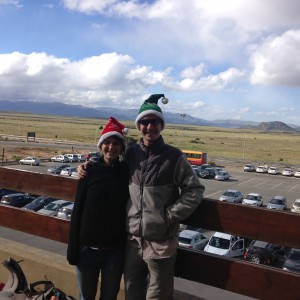
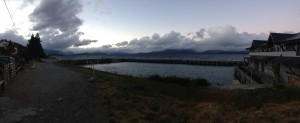
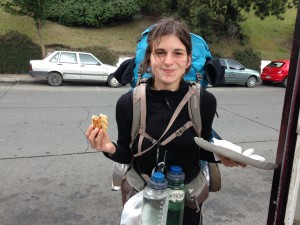
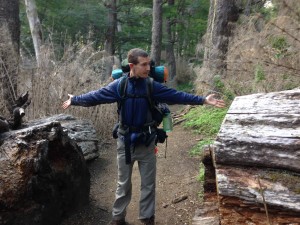
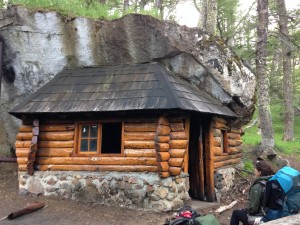
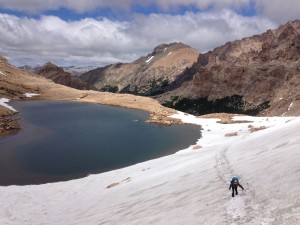
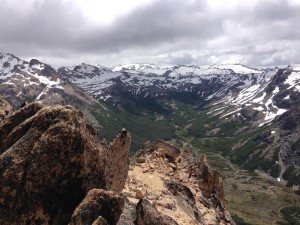
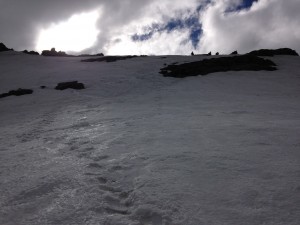
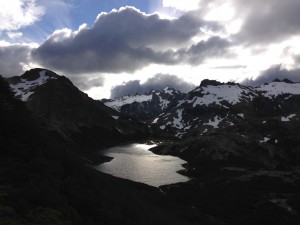
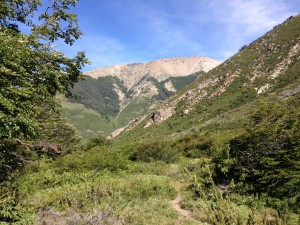
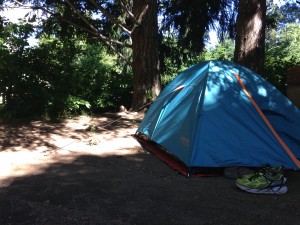

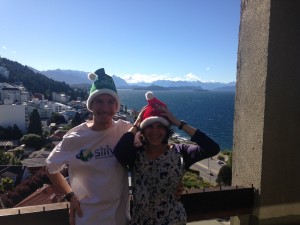
Leave A Comment